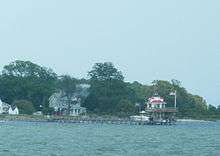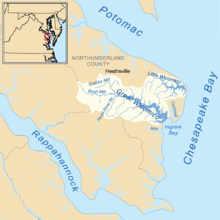Great Wicomico River
| Great Wicomico River | |
|---|---|
 | |
 | |
| Country | United States |
| Basin | |
| Main source | Virginia |
| River mouth |
Ingram Bay 37°49′44″N 76°19′2″W / 37.82889°N 76.31722°WCoordinates: 37°49′44″N 76°19′2″W / 37.82889°N 76.31722°W |
The Great Wicomico River is a 15.2-mile-long (24.5 km)[1] river in the U.S. state of Virginia,[2][3] located approximately 60 miles (97 km) northeast of Richmond. In 1864, during the American Civil War, one of the torpedo boats of Admiral David Dixon Porter's fleet ran into the Great Wicomico River and was captured.
Geography
The Great Wicomico is a small tidal tributary on the western shore of the Chesapeake Bay.[4] It is fed by the freshwater Crabbe Mill Stream and Bush Mill Stream. The Great Wicomico flows into a trap-type estuary on Ingram Bay, with a history of significant natural spat settlement and seed oyster production. Oyster production is risky, given the high risk of disease.[5] There are three sentinel sites present. The reefs were constructed in 1996 and 1998. The western shore of the Chesapeake Bay between the Rappahannock River and the Great Wicomico River is generally low with no prominent features.[6] Dolphins are occasionally sighted in the river estuary.[7]
Fishing
The Dameron Marsh area near the river mouth is said to be a good area for fishing, especially stripers and trout and Spanish mackerel during the summer months.[8]
Large numbers of menhaden afflicted with lesions are periodically caught in the Great Wicomico, and a fish kill of at least 100,000 was observed by scientists in September, 2001.[9]
Landmarks
The Great Wicomico River Light was a screwpile lighthouse erected in 1889 at the mouth of the Great Wicomico River. The original structure was deactivated in 1967; the lighthouse superstructure was dismantled and replaced with an automated skeleton tower mounted on the original pile foundation.[10] In September 2015 the remaining structure was removed. Today, a lighthouse-shaped folly, not recognized as a navigational aid, marks the entrance of the river in Fleeton.[11] Several wrecks are located in the Ingram Bay in the mouth of the rivers; of note are the Davidson, Old Texas and San Marcos wrecks.[8]Jesse Dupont Memorial Highway 200 crosses the river several kilometres from the mouth near the Athena Vineyards and Winery.
See also
References
- ↑ U.S. Geological Survey. National Hydrography Dataset high-resolution flowline data. The National Map, accessed April 1, 2011
- ↑ Salmon, Emily J.; Edward D. C. Campbell, Jr. (1994). The Hornbook of Virginia History (4th ed.). Richmond, VA: Virginia Office of Graphic Communications. ISBN 0-88490-177-7.
- ↑ USGS Geographic Names Information Service
- ↑ USGS Hydrologic Unit Map - State of Virginia (1974)
- ↑ "Virginia Oyster Reef Restoration Map Atlas". Virginia Institute of Marine Science.
- ↑ United States coast pilot: Atlantic Coast. Sandy Hook to Cape Henry Serial, U.S. Coast and Geodetic Survey, G.P.O., (1937)
- ↑ Shellenberger, William H. (2001). Cruising the Chesapeake: A Gunkholer's Guide (3 ed.). McGraw-Hill Professional. p. 74. ISBN 0-07-136371-8.
- 1 2 Russell, Ed, May, Bill (2002). Flyfisher's guide to Chesapeake Bay. A Wilderness Adventures Flyfishing Guidebook Series. Wilderness Adventures Press. p. 303. ISBN 1-885106-94-7.
- ↑ Fungal lesions linked to fish kills both with, without Pfiesteria in the Chesapeake Bay Journal
- ↑ de Gast, Robert (1973). The Lighthouses of the Chesapeake. Johns Hopkins University Press. p. 155.
- ↑ Rowlett, Russ. "Lighthouses of the United States: Virginia". The Lighthouse Directory. University of North Carolina at Chapel Hill.